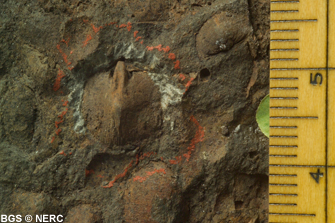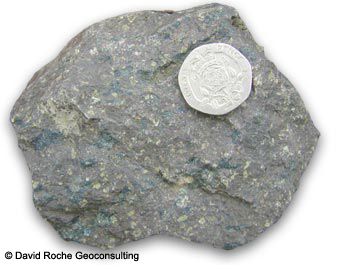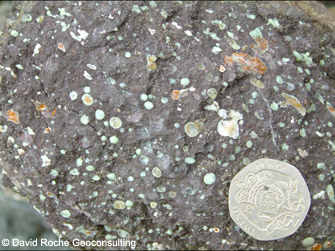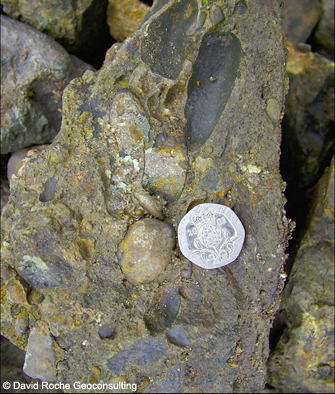
The rocks of Mendip
Silurian | Devonian | Lower Carboniferous | Upper Carboniferous | Triassic | Lower to Middle Jurassic
Silurian rocks (444 to 416 million years ago)
The Silurian rocks of the Mendips are formally known as the Coalbrookdale Formation, and occur as a narrow elongated outcrop in the core of the eroded anticlinal fold that forms Beacon Hill, north-east of Shepton Mallet. The rocks comprise a sequence of fissile mudstones ('Wenlock Shales') around 600 m thick overlain by an interbedded succession of tuffs, agglomerates and andesite lava flows. A vent agglomerate represents a section through an ancient volcanic fissure, fortuitously exposed at the surface because of the almost vertical dip of the strata. Volcanic rocks are rare in the Silurian, and the Mendips are one of the few places in the UK where they can be observed.
'Wenlock Shales'

These siltstones and fissile mudstones contain the remains of brachiopods, including Eocoelia angelini, suggesting a correlation with the lower Wenlock part of the Silurian. They were once thought to form the youngest part of the Silurian succession, before it was realised that the beds had been inverted. In the Welsh borderland, fossil brachiopod 'communities' in Wenlock-age sediments characterise different ancient environments from deep to shallow marine settings. Two of these same communities, the Isorthis clivosa community, overlain by the Salopina conservatrix community (each named after the dominant brachiopod), occur at successive levels in the 'Wenlock Shales' of the Mendips, and indicate a shallowing upward trend from deeper shelf to restricted inshore conditions. This shallowing probably reflects local uplift associated with the impending eruption of the overlying volcanic succession.
Tuff

Volcanic ash that has become consolidated into rock is known as tuff. In the Mendip succession, tuffs are typically grey and grey-green weathering, and can range from fine-grained to coarse-textured units, the latter containing clasts up to 25 mm in diameter. At some levels in the Mendip succession the tuffs are graded and cross-bedded, suggesting that they were deposited in water.
Andesite

Andesite is a type of lava. Today these lavas erupt from volcanoes at continental margins where oceanic crust is being destroyed in the process known as subduction (for example Mount St Helens in North America). A similar setting might be inferred for the Silurian of the Mendips. Several separate andesite lava flows occur, and many of these contain small mineral-filled cavities known as amygdales. The cavities formed by the escape of hot gases as the lava was erupted, and subsequently they became the sites for mineral precipitation, particularly calcite. The 'Main Andesite' beds, at least 390 m above the base of the Silurian succession, comprise four major flows that are quarried at the Moon's Hill Quarry [ST 662 461]. The tops of some of these flows are reddened and eroded, suggesting that they were erupted under terrestrial conditions, although 'pillow' structures seen in andesites towards the top of the Silurian succession in the Mendips suggest a submarine eruption.
Agglomerate and vent agglomerate

Agglomerate is rock composed of broken lava fragments (larger than 20 mm in diameter) in a fine matrix, formed by explosive volcanic eruption. In the Mendip succession, the clasts are typically up to 150 mm, and occasionally up to 200 mm in diameter, but are often very weathered. The matrix is typically fine, grey or slightly purple weathering. At least three agglomerates occur in the upper part of the Mendip succession, and one of these has been interpreted as a vent agglomerate, infilling a fissure through which lava was erupted. Vent agglomerates normally infill steeply dipping volcanic vents and fissures and would normally not form extensive outcrops at the surface. Here the steep dip of the Silurian succession in the Mendips has allowed much of this unusual deposit to be seen at the surface.
- Home
- Overview maps
- Locality
areas
- Cheddar Gorge
- Charterhouse
- Blackdown
- Burrington Combe
- Shipham & Rowberrow
- Crook Peak & Axbridge
- Banwell to Churchill
- Priddy
- Harptree & Smitham Hill
- Draycott & Westbury-sub-Mendip
- Wookey Hole & Ebbor Gorge
- Wells
- Great Elm & Vallis Vale
- Mells & the Wadbury Valley
- The Vobster area
- The Whatley area
- Torr Works & Asham Wood
- Beacon Hill
- Stoke St Michael & Oakhill
- Holwell & Nunney
- Shepton Mallet & Maesbury
- Gurney Slade & Emborough
- The Nettlebridge valley
- Geology
- Minerals and mines
- Quarrying
- Caves and karst
- Biodiversity
- Detailed site information
- Acknowledgements
- External links
- Search
- Site map